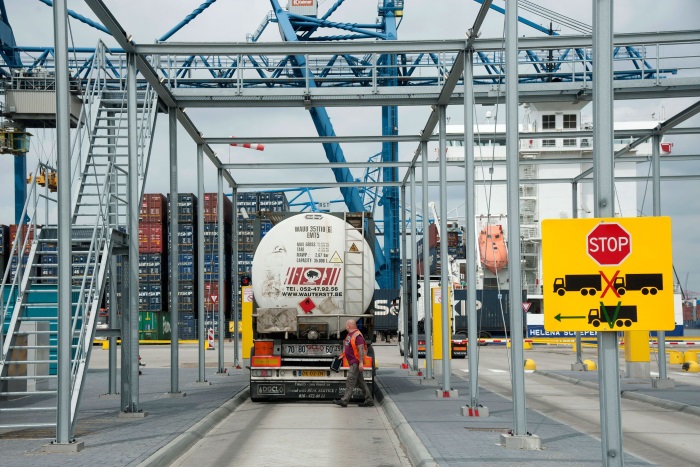New City Terminal entrance improves accessibility of Rotterdam’s city and port
This morning, on Thursday 22 June, the redeveloped entrance of the City Terminal on Eemhaven (Gate Reeweg) was officially opened by Floor Vermeulen, Member of the Provincial Executive of Zuid-Holland. The new entrance and the surrounding infrastructure will considerably improve the accessibility of both the city and the port area. In time, the new gateway and the accompanying internal circuit will be able to handle some 3,000 trucks per 24 hours, including peaks of up to 450 trucks per hour. This high capacity is by no means a luxury, since soon the City Terminal will be accommodating a multi-purpose port and industrial area for both shortsea and breakbulk cargo – with throughput and traffic volumes that are substantially higher than previously handled in the area.

The redevelopment of Gate Reeweg is in line with the large-scale restructuring of the terminals and infrastructure at ECT’s former Home Terminal. The area’s rejuvenation will create a unique, multimodal shortsea cluster that offers outstanding access to the various markets in the European hinterland via inland shipping, rail and road. “The development of this new gate and the City Terminal fits in with the Port of Rotterdam Authority’s overall policy, which is geared toward ensuring that the port remains accessible while revitalising and making new use of former port areas near the city,” says Port Authority COO Ronald Paul. The new entrance to the City Terminal was realised in part thanks to the financial support of the Province of Zuid-Holland and the Municipality of Rotterdam: “The new terminal enhances the strengths of the port of Rotterdam. This is good news for the economy and employment. Not just in the port, but also in Zuid-Holland’s agricultural hubs, the so-called Greenports. The port of Rotterdam is becoming increasingly important for the import of fresh produce – and, in the near future, also the export from the Greenports. That is why we have invested in shared facilities and solid infrastructure in the vicinity of the terminal,” says Floor Vermeulen, Member of the Provincial Executive of Zuid-Holland.
Accessibility
In the days of the Home Terminal, you could regularly see congestion developing during peak hours along Reeweg: the road that connects the terminal with the A15 motorway. At the time, a maximum of some 900 trucks per 24 hours would call on the terminal. In the new situation, the Port Authority expects up to 2,500–3,000 trucks to visit the terminal every day. Nevertheless, it expects far fewer traffic jams, thanks to extensive automation, the construction of a considerable number of extra parking spaces, the use of the CargoCard and adaptations to the infrastructure. As an extra measure to ensure that these future traffic flows are settled quickly and efficiently, the Port Authority recently adapted the Reeweg-Bodaanweg intersection on the public road. This junction provides access to and from the A15 motorway. In 2016, an extra lane was added to the intersection and the traffic lights systems were adapted, to better direct the through traffic moving from and to the A15 motorway and traffic turning on or off the road to the City Terminal.
Shortsea cluster
The substantially upgraded gate is more effectively tailored to the diverse requirements of the City Terminal’s different users: SCA (breakbulk), RST (containers), RSC (rail terminal), Kramer (container repairs and storage), the customs office, MRS (container services), and Kloosterboer (temperature-controlled cargo). An agreement has been reached with Steinweg, the owner of the container terminal operators RST and Uniport, regarding a contract extension and the expansion and further growth of the shortsea segment. New agreements with Kramer and MRS outline the realisation of two new empty depots on the site that will also focus on the additional handling of reefer containers. In addition, talks are being held with RSC about possible further expansions.
Cool Port
An important pillar of the present redevelopment is Cool Port, a new cold store for refrigerated and frozen cargo in the heart of the shortsea area. Cool Port, which is part of the Kloosterboer Group, is expected to generate new cargo flows and employment for Rotterdam. Cool Port has since welcomed its first shipment.
Source: Port of Rotterdam
HEADLINES
- Do shipping markets want Biden or Trump for the win?
- All 18 crew safe after fire on Japanese-owned tanker off Singapore
- Singapore launching $44m co-investment initiative for maritime tech start-ups
- Cosco debuts Global Shipping Industry Chain Cooperation Initiative
- US warns of more shipping sanctions
- China continues seaport consolidation as Dalian offer goes unconditional